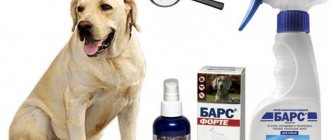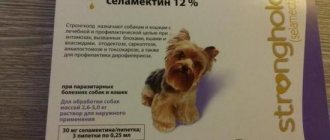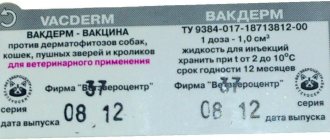January 27, 2016
They are everywhere! It’s probably fortunate that we cannot see them with the naked eye, because no horror film can compare with the picture that opens when you look at the surface of the earth under a microscope. They are the larvae of parasites, and no dog walking along the street with its paws can avoid picking up hundreds of these microscopic creatures, and then safely swallowing them. And that’s all the parasites need!
There is an opinion that since there is literally no way to hide from parasites, their entry into the body is a natural phenomenon that should not be feared. This is completely false!
Helminthic infestations, if left untreated, lead to serious consequences: decreased immunity, pathologies in tissues, internal organs and blood vessels - and subsequent early death of the animal. So what kind of parasites do dogs have? Let's talk about the most “popular”.
Classification of parasites in dogs
Parasites are organisms that inhabit the body or inside the host and feed at its expense. A dog owner should know what parasites look like. This will help you quickly detect them and take the necessary measures.
Photos of parasites in dogs clearly reflect their appearance and size. Some of them pose a danger to humans because they are zoonotic, that is, pathologies caused by them, or they themselves can be transmitted from animals to humans. Dogs have external and internal parasites.
- External or skin parasites in dogs (ticks, fleas) live on the body of their owner. They can infect the animal with various diseases and cause the development of dermatological diseases. Fleas and ticks on a dog cannot be transmitted to humans, however, they can bite him and cause discomfort.
- Internal parasites (tapeworms, roundworms, hookworms), penetrating the body, are localized in different organs and tissues of the animal, causing disruption of the functionality of the organs, poisoning the body with the products of their vital activity.
Dog ticks in dogs: photos and treatment
The lifestyle of different types of blood-sucking ticks is largely similar. They all need animal blood to reproduce. The female, having sucked blood, falls away from the animal and only then lays eggs. All common blood-sucking ticks on dogs go through four stages: egg, larva, nymph and adult.
The female tick lays 3000-6000 eggs on the surface of the ground. They hatch into six-legged larvae (seed mites), which attach themselves to field mice or other small rodents. A few days later, having sucked blood, they fall to the ground, shed their skin and appear with eight legs. This is the nymph stage. Then they again attach themselves to small rodents, fill with blood, after 3-10 days they fall to the ground, shed their skin, and this time emerge as adults.
Mating in ticks occurs when a female and a male, clinging to a dog, suck its blood. After 5-13 days, the female falls to the ground, lays eggs and dies. The only food ticks eat is the blood of mammals. Larvae and nymphs can live without food for a year, and adults - two years. Next, you can see a dog tick in the photo, which illustrates sexually mature individuals:
Brown dog ticks are the biggest nuisance because they can live in homes and dog kennels, feeding exclusively on the blood of dogs. Adult ticks do not bite humans. At some stages they hide in furniture, folds of curtains, baseboards or window frames. To get rid of these ticks, you need not only to treat the dog with the appropriate drug, but also to destroy their nests in the room.
To treat ticks in dogs, use special medications and carefully examine your dog every day. There is a whole arsenal of acaricides and insecticides. But ticks adapt very quickly to poisons. A tick repellent that was very effective yesterday may not work the next day.
Why are parasites dangerous for dogs?
Experts say that most pets suffer from helminthiasis, that is, they are carriers of parasites, and at the same time they look healthy. You can protect your dog's health by being careful and following the veterinarian's instructions.
Lack of treatment may cause:
- Decreased immunity, cessation of development as a result of a deficiency of nutrients in the body.
- Irritability and nervousness due to constant discomfort, pain and itching.
- The development of serious and dangerous diseases against the background of infection and weakened immunity.
- Severe intoxication and allergic reaction as a result of the release of toxic metabolic products by parasitic organisms.
- Diseases of the brain, heart, liver, lungs and other organs.
Lack of treatment can lead to the development of epilepsy, intestinal obstruction, loss of vision and other serious complications, as well as cause the death of the dog.
Zoonosis
People can become infected with hookworms through contact with contaminated soil. Hookworm larvae can burrow through the skin, potentially leading to a relatively minor but rather unpleasant condition called cutaneous larval migraine.
Avoid walking barefoot in areas where pets have defecated (including beaches). Always wear gloves when handling any soil, especially soil that may have come into contact with dog feces. Children should never play or sit in areas where pets may have defecated.
Transmission routes
Basically, infection with worms occurs due to the ingestion of their eggs and larvae along with contaminated water, food or dirty soil. Parasites can enter the body through the skin if it is damaged. Heartworms can be transmitted by insect bites. A puppy can become infected from a mother who has helminthiasis.
A dog can become infected with skin parasites through contact with another animal. Fleas can enter your home through windows and doors. They can be brought into the house by a person on his shoes or clothes.
Fleas can become a carrier of tapeworms if a dog eats an animal infected with external parasites. A dog can pick up ticks while walking in nature.
A dog can become infected with parasites if:
- The pet owner does not comply with sanitary and hygienic standards;
- The dog does not undergo deworming to prevent the development of helminthiasis;
- Feeding rules are violated, the animal is fed raw meat, leftovers or low-quality food;
- The owner does not limit the dog’s contact with street animals;
- Individuals infected with worms live in the house with the dog.
Treatment and prevention of parasitic lesions
Despite the widespread prevalence of parasitic diseases in dogs, there are currently medications that can not only rid a dog of parasites, but also prevent infection.
To combat fleas and ticks, including diseases such as otodectosis (ear mites), sarcoptic mange (scabies) and demodicosis, it is convenient to use Simparica tablets. For the treatment and prevention of these parasitic diseases, a monthly intake of Simparika according to the instructions is sufficient. Simparika tablets can be given to both adults and puppies over 8 weeks of age with food or separately.
To treat and prevent infection by fleas, lice eaters, scabies mites, and roundworms, you can apply Stronghold drops to intact, dry skin in areas that are inaccessible for licking. The drug quickly spreads throughout the dog’s body, and even washing with shampoo two hours after applying Stronghold does not reduce its effectiveness.
The drug is used for the treatment and prevention of diseases in dogs caused by parasites; it is used in adult dogs and puppies over 6 weeks of age. To prevent infection with dirofilariasis, Stronghold drops must be applied monthly during the entire flight period of insects. To prevent infection with peloderosis, it is important not only to treat dogs with drugs that are active against round helminths, but also to prevent dogs from coming into contact with contaminated soil and rotting bedding.
In case of ear scabies or otodectosis, the ear canals are cleaned with lotion and, if necessary, a course of treatment with anti-inflammatory and antimicrobial drops is carried out in consultation with a veterinarian. Fortunately, to kill ear mites, there is now no need to apply irritating acaricides to the inflamed ear canal. To treat ear scabies, you can apply Stronghold drops to the intact skin of the neck or give a Simparic tablet orally. To prevent infection of ear mites in animals going outside, it is recommended to carry out treatments monthly.
Zoonotic parasites
Pet owners are interested in which dog parasites are transmitted to humans. A large number of helminth eggs accumulate at the anus.
By licking itself, the animal transfers them to other areas of the body. Close contact with a dog can lead to infection. Most often, tapeworms and roundworms migrate from dogs.
The tick is also dangerous for humans, as it easily spreads to the epidermis, clothing and bedding of a person upon contact. When petting your dog, you can become infected with scabies, ringworm and dermatophytosis (fungal infections).
Care
Treatment for hookworm is the same as for roundworms. Several oral doses of deworming medication must be taken because deworming medication can only kill worms in the intestinal tract. A dewormer, usually given during puppy vaccinations, also treats hookworms.
Not all over-the-counter dewormers are effective, so ask your veterinarian about a suitable medication. Note: Several types of heartworm preventatives also protect against hookworm infections.
Symptoms of parasites in dogs
You can detect your pet's infestation with parasites at an early stage by regularly visiting the veterinary clinic and taking tests. Symptoms of infection in a dog can vary and depend on the type of parasite, the area of its localization and the degree of infection.
When infected with skin parasites, the dog actively scratches various surfaces and makes movements with its jaws. Your pet may experience redness of the skin, loss of fur, accumulation of black spots in the ears, nervousness, as well as fleas and flea droppings.
With helminthiasis in dogs the following are observed:
- Diarrhea, sometimes you can see blood and mucus in the feces;
- Vomiting;
- Loss of appetite and weight loss;
- Bloating, alternating constipation with diarrhea;
- Decreased activity, weakness, apathy;
- Skin rashes;
- Worm fragments or segments in feces;
- Respiratory dysfunction.
A change in your pet's behavior and the appearance of one of the symptoms listed above is a signal that the dog has health problems. It is necessary to urgently contact a specialist.
You cannot start treating an animal on your own, without consulting a veterinarian. The veterinarian selects a remedy for parasites for dogs only after diagnosing the disease and determining the type of parasite.
Symptoms of a domestic dog being infected with parasites
Fleas
The first sign that a dog has fleas is itching, especially in the belly, neck, sides, back and tail.
There may be no obvious lesions, or they may appear as small red spots. In dogs with an allergy to flea saliva, even a single flea bite can cause severe itching, and the fleas themselves may not be detectable. With intensive infestation, the fur becomes sparse and dull, and you can also find fast insects flattened on the sides, or their feces in the form of dark grains.
As a result of flea bites and allergies to their saliva, secondary inflammation of the skin can develop with extensive redness of the skin, pustules and crusts. Gradually, the hair falls out, the skin darkens and thickens.
Photo. Scratching, hair loss and redness of the skin in the neck and head caused by flea bites.
Photo. The same dog with itching. Note the dry, sparse coat on the back and rump.
Photo. The same dog with itching associated with flea allergy dermatitis. Note the sparse fur and redness of the skin.
Subcutaneous mites
Microscopic parasitic mites are often the cause of hair loss and itching. With cheyletiosis, itching, flaking of the skin with the formation of abundant dry dandruff, and baldness are noted. Most often, the disease begins in the back area. Sarcoptic mange is characterized by intense itching, redness of the skin, baldness (alopecia), and the formation of crusts, especially around the edges of the ears, on the elbows, chest and lower part of the pelvic limbs. With extensive damage, exhaustion and poisoning of the body with toxins may occur, leading to the death of the animal.
With otodectosis, or ear scabies, the main lesions are observed in the area of the auditory canals - the dog scratches the ears and neck area, while copious dark dry discharge, reminiscent of dry tea leaves, is found in the outer ear.
Otodectosis is often complicated by purulent inflammation of the outer ear (otitis externa), then the infection can spread to the middle and inner ear with the development of neurological disorders (head tilt, lack of coordination, convulsions, involuntary eye movements, etc.).
With demodicosis, tubercles (papules), hair loss (alopecia), initially focal, later extensive, peeling, crusts, pustules with bloody contents are noted. The dog emits a characteristic “mouse” smell. Demodicosis is rarely accompanied by itching, however, with the development of bacterial complications, itching may develop. If skin diseases caused by subcutaneous mites are suspected, microscopy of scrapings and plucked hairs from the affected areas is performed to confirm the diagnosis and carry out treatment.
Photo. Patchy hair loss (alopecia) and reddening of the skin in a dog with demodicosis.
Helminths
The larvae of round helminths can cause specific skin diseases - helminthiasis. One of the rare skin helminth infections is peloderosis, caused by infection with the free-living round helminth Pelodera strongyloides. The disease manifests itself more often on areas of the skin in contact with contaminated soil or litter (limbs, abdomen, chest, tail).
Sick dogs experience redness of the skin, hair loss in the affected areas, and possible itching. A secondary infection often develops, in which case crusts appear or the lesions become moist. The diagnosis is confirmed when helminth larvae are detected when examining skin scrapings or plucked hair under a microscope.
Another skin helminthiasis - cutaneous dirofilariasis - is manifested by chronic inflammation of the skin with the formation of nodules and knots ranging in size from 0.5 cm to 4 cm, crusts, and sometimes ulcers on the skin of dogs. The head and extremities are most often affected, although lesions can occur in any other area. The disease is transmitted through the bite of an infected mosquito or mosquito.
With intestinal helminthiases, in addition to signs of digestive disorders (vomiting, unstable stools), exhaustion with increased appetite and high-quality feeding, the quality of the coat may deteriorate. When infected with cucumber tapeworm, which is transmitted through fleas and their larvae, moving tapeworm fragments resembling rice grains can be seen in the feces of infected dogs. Some dogs with this disease experience itching at the base of the tail.
Types of parasites in dogs
Pet owners and breeders need to know what parasites can be found in dogs and how to deal with them once a diagnosis of helminthiasis is confirmed.
All types of worms are divided into three groups: Flat or cestodes, round or nematodes and flukes or trematodes.
Cestodes include:
- Cucumber tapeworm up to 65 cm long, living in the small intestine.
- Echinococcus and alveococcus. Parasites multiply in the small intestine, then penetrate the blood vessels, migrate to internal organs, most often to the lungs, kidneys, muscle tissue, brain, and liver.
Nematodes are:
- Hookworms up to 2 cm long, localized in the small intestine.
- Dioctophyma, living in the kidneys, in the abdominal cavity, in the ureter and bladder. This type of worm can be an intermediate host for filamentous worms localized in the bladder.
- Toxocara, the eggs of which are ingested along with food, feces and through contact with an infected animal. Through the walls of the small intestine they move into organs and tissues, forming a capsule around themselves and causing serious consequences.
- Trichocephalosis affecting the digestive tract.
- Heartworm is transmitted through insect bites. Once in the bloodstream, it migrates to the internal organs, where it continues to grow until the sexually mature phase.
- Thelyasia are localized in the conjunctival sac. Spread by fruit fly.
Trematodes have a flat shape with suckers (one or two). There are minimal sizes, the largest reach 2 cm. These include:
- Alaria, the larvae of which enter the dog's body when eating ferrets, mice or frogs. After entering the pet, parasites are localized in the lungs, mature and migrate to the intestines.
- Opisthorchia. They live in internal organs in the sexually mature phase. They enter the body when feeding an animal raw fish.
- Paragonims invade the respiratory organs and the brain. Infection occurs through a dog eating raw crayfish.
Ringworm in dogs: photos and treatment
Ringworm in dogs combines three infectious diseases - trichophytosis, microsporia and scab, the causative agents of which are pathogenic dermatophyte fungi. These diseases have similar symptoms and treatments. They are also dangerous for people.
In dogs, ringworm begins as small spots, usually round or oval, covered with a gray or tan crust. Almost all hair falls out of these affected areas. The spots appear most often on the face, head or paws, but can also appear in other places. As the disease progresses, the bald spots increase. The spots disappear after a while, but appear in a different place. When a dog scrapes off the scab to relieve the itching, a bleeding wound remains at the site. Sometimes there is little or no itching. Look at the photos of ringworm in dogs that show the symptoms of this parasitic disease:
For an accurate diagnosis, doctors examine hair from the affected areas under a microscope. For microsporia, fluorescent diagnostics are performed using a mercury-quartz lamp with a Wood filter. This analysis is necessary because ringworm is caused by several types of fungi, and depending on the type, treatment is prescribed. Moreover, the appearance of bald patches, which you can independently diagnose as lichen, in 20-30% of cases turn out to be symptoms of other diseases. They may be signs of vitamin deficiency or a weakened body.
Based on the results of the examination of the animal, the doctor will prescribe a treatment regimen, which will be based on the following measures (one or more): the use of vaccines for preventive and therapeutic purposes; prescription of specific antifungal drugs; taking immunomodulators; local treatment of affected skin areas with antiseptics.
When treating ringworm in dogs, it is very important to observe personal safety measures: collect and burn rejected crusts and hair and disinfect the room and care items.
Acne is the result of inflammation of the hair follicles or sebaceous glands. In dogs, pimples often appear under the collar, where dirt and germs are rubbed into the skin. A boil or carbuncle may appear at the site of the pimple.
A ripe pimple is opened, the pus is washed off and the wound is moistened with some non-irritating antiseptic such as hydrogen peroxide. Ichthyol ointment, if vigorously rubbed into a nascent pimple, can kill microbes from the inside and the pimple will disappear.
Diagnosis of parasites
Only a specialist can determine the type, stage and degree of infection. The doctor prescribes a stool test and, if necessary, a blood test, which helps determine the pet’s condition and the level of functional changes in the body.
If helminthiasis is suspected, affecting the heart, bladder, lungs and liver, an ultrasound or radiography is prescribed.
Diagnostics
Diagnosing whipworm infections can be difficult because they do not lay eggs continuously like roundworms and hookworms. Your veterinarian will perform a laboratory test called fecal flotation (as is the case for roundworms and hookworms).
Whipworm eggs may or may not be visible under a microscope if adult whipworms are present in the small intestine. The absence of eggs in a stool sample does not definitively rule out a whipworm infection. Your veterinarian may recommend repeat stool testing if whipworms are suspected.
Treatment of parasites in dogs
The therapeutic course is aimed at destroying eggs and adult worms. The choice of drug, course and duration of treatment is determined by a specialist.
- Treatment of a dog after diagnosis and prescription of therapeutic treatment is also possible at home.
- In some cases, treatment is organized through surgery, when the dog is operated on, removing a section of infected tissue along with worms.
Tapeworms
Tapeworms (Dipylidium caninum) are intestinal parasites that commonly affect dogs. These are long flatworms (tapeworms) that attach to the small intestine of the host. The body of a tapeworm is several inches long, but consists of several segments that grow on the head and neck of the worm. Each segment has its own reproductive tract.
Dogs get tapeworms from fleas. Flea larvae hatch from eggs and ingest surrounding dirt and debris. If present, they will also eat tapeworm eggs.
Larval fleas develop into adults when tapeworm eggs develop inside the fleas. Adult fleas jump on their host (usually a dog or cat) and cause the pet to itch. The host chews itself and eats the adult flea, then the developing tapeworm enters the host. The young tapeworm attaches to the small intestine and grows into segments.
The terminal segments are egg sacs that eventually separate and exit the host's rectum into the environment. A segment of the tapeworm, which resembles a grain of rice or sesame seed, opens and the eggs are released. If flea eggs are also present in the environment, the life cycle repeats. Therefore, tapeworms are transmitted from pet to pet only through fleas.
Medicines for parasites
In veterinary practice, anthelmintic drugs are used in the form of tablets, injection solutions, pastes or drops for external use.
- Effective tablet drugs include Drontal plus and Milbemax. The active component of the medications penetrates the membrane of the parasites into the central nervous system and kills them.
- Injection solutions are injected subcutaneously or into the muscle. Due to rapid entry into the bloodstream, they have an accelerated effect. Available in powder form (dissolved in saline solution). Used to treat large breed dogs and large-scale infections. An effective drug is Droncit.
- Pastes or suspensions, produced in 50-100 ml quantities, are used to treat small dogs and puppies against parasites. They are applied to the pet's cheek. Veterinarians prefer the drugs Drontal Junior and Prazicide.
Medicines in the form of drops are used to treat external parasites. The best are Lawyer and Inspector.
- The active component of the drugs is absorbed into the dog’s bloodstream, destroying parasites and preventing their further reproduction.
- The disadvantage of these funds is the cumulative effect in tissue structures, causing intoxication.
External parasites of cats and dogs
External parasites are a serious and very common problem faced by cat and dog owners. Owners often underestimate the danger posed by pests. In this article, we will consider the main types of parasites that can settle on a pet’s body.
Types of parasites and harm from them
Ixodid ticks
Ticks that live in the grass in parks, meadows and even in the city, and wait for a person or animal to pass by. They can carry piroplasmosis, ehrlichiosis, anaplasmosis, borreliosis, and other diseases. Read the article about ticks.
Demodex
The mites of the genus Demodex that cause demodicosis are D. Canic in dogs, D. Cati and D. gatoi in cats. Normally, a small number of these species-specific mites live in the hair follicles and do not cause harm. However, under certain conditions, mites begin to multiply excessively, causing unbearable itching, skin damage, scratching, alopecia and the development of secondary infections. The disease does not require intensive treatment in the juvenile form in puppies, but requires increased attention in the generalized form, in which almost the entire surface of the skin is damaged. In cats, demodicosis is rare and is more often associated with an immunosuppressive state.
Ear mite
Microscopic mites Otodectes cynotis, which parasitize the external auditory canals, causing otodectosis. As a result of the activity of mites in the ears, microtraumas, irritation, swelling and severe itching occur. The animal is depressed and nervous, scratching its ears, often turning its head to the affected side, shaking its head. Often, with severe itching, the animal itself severely injures its auricle and the adjacent skin around it, and a secondary infection can also occur. With severe damage, even death is possible.
Scabies mites
Scabies mites of the genus Notoedres cati fam.
Sarcoptidae live and reproduce in the thickness of the epidermis. Notoedrosis is a highly contagious disease among cats and rabbits; dogs can become infected, but less frequently; mites live mainly on the head; with severe infection, they spread to the neck, chest and paws. Ticks from the genus Sarcoptes, which feed on particles of dead skin, lymph, and serous exudate, most often infect dogs.
Both types of mites gnaw passages in the skin, causing unbearable itching and serious damage to the skin involving secondary microflora. The skin thickens, bleeds, later becomes covered with crusts, after about 3 weeks the itching intensifies sharply, the thickened, swollen skin becomes covered with deep cracks, conjunctivitis appears, the animal is lethargic and loses weight. In dogs, anorexia occurs, and in cats, their appetite may remain. Without treatment within 2 months the animal dies.
Fleas
95% of fleas live in the environment and only 5% on animals. These parasites can bite cats, dogs, and people. When bitten, they can infect your pet with infectious diseases. If a flea is accidentally swallowed, your pet may acquire a tapeworm called Dipylidium. Also, flea allergic dermatitis, which occurs as a result of the body's reaction to flea saliva, is common in many animals. For old, weakened pets, puppies and kittens, a serious flea infestation is dangerous with the risk of developing anemia and, in some cases, even death.
Lice and lice eaters
Lice feed on blood and lymph, while lice eaters feed on particles of skin, fluff, and secretions of the sebaceous glands. Lice have an elongated body, a narrow small head, and they move slowly. Infection occurs through close contact with an infected animal. The animal itches, gets nervous, the quality of the coat deteriorates, dandruff and crusts appear, allergic dermatitis appears, and with a large number of insects, the weak, sick, elderly and young can develop anemia. Lice eaters have a larger head and a gnawing mouthpart; they do not drink blood. When infected with them, alopecia, general deterioration of the coat, dandruff, itching, dermatitis, saliva and discharge cause an allergic reaction. Lice eaters choose the area of the tail and head as their habitat on the animal. They are intermediate hosts of the cucumber tapeworm tapeworm Dipylidium. Lice eaters are more often found in cats (often together with other types of parasites).
Mosquitoes, flies
These insects do not constantly parasitize the animal. Mosquitoes can infect your pet with heartworms called heartworms. Not all types of flies are capable of biting. But those flies that can - for example, horseflies and lifers - bite cats and dogs on the ears and nose. As a result, wounds form, the skin becomes inflamed, itches, and ichor is secreted, which further attracts flies. They can carry dangerous diseases such as tularemia, anthrax, and sometimes lay eggs on the skin and in the wound, where larvae then develop.
Symptoms of parasite infestation and diagnosis
Symptoms of the presence of external parasites in an animal can vary. The main ones include:
- Itching. The animal scratches and chews certain areas of the body. Sometimes the itching is so severe that the pet significantly injures the skin and becomes restless and aggressive.
- Hair loss, dull color. Hair can fall out in small areas or can affect almost the entire surface of the body.
- Skin damage: peeling, dandruff, redness, rashes, blisters and crusts.
Diagnosis is easy when it comes to ixodid ticks, myiasis, or if adult fleas are found on the animal.
Otherwise, there is no way to do without additional diagnostics. To exclude flea infestation, use a simple “wet test”: comb the fur over a wet sheet of white paper. If the result is positive, there will be small black grains on it, which, when rubbed, leave a red-brown color - this is flea feces, digested blood. To detect microscopic mites, you will need to take a deep and superficial skin scraping or swab from the ear for examination under a microscope. This method is also used to monitor the effectiveness of treatment.
Control methods and prevention
The best defense is prevention. To protect your pets from external parasites, you need to remember the basic rules:
- All animals in the house need to be protected at the same time.
- Do not forget about regularity, read the instructions for the drugs, which describe the duration of action.
- It is not recommended to bathe the animal two or three days before and also after treatment with drops and sprays.
- Inspect the animal from time to time, regardless of the type of treatment.
Preparations for treating animals exist in several forms: tablets, drops, spray, collar.
- Tablets for dogs
Bravecto, Simparica, Frontline Nexgard. Tablets that help preventively protect the animal from fleas, ixodid ticks and demodexes. They are also effective in the treatment of demodicosis. Convenient for owners of several dogs, there is no risk of poisoning when licking each other, as well as for owners of dogs who often bathe and are in the forest and field. Not suitable for cats.
- Drops
The most common type of flea and tick medication.
They are applied to the skin at the withers, the average duration is 1.5-2 months. You need to pay attention to the spectrum of effects of the drops: for example, there are those that act against fleas, ticks and helminths (Inspector, Prazicide complex), those that act against fleas and ticks (Bars, Prac-tik, FleaNet, Rolf Club, Frontline Combo, Bravecto Spot-on), flea only (Advantage for cats), and has a mosquito repellent effect (Advantix). Drops from otodectosis are dripped into the ears according to the instructions.
- Sprays
They are applied to the skin and fur, most often used as an aid for forest walks and for the treatment of anti-tick overalls.
- Collars
Collars are available both based on essential oils - repellent, and on the basis of chemicals. The validity period, depending on the type, is from 1 to 8, and even 12 months. Foresto and Protecto have the longest validity period. The collar should fit snugly to the animal's skin.
- Shampoos
Shampoos have a lower protective function, but help with existing parasites. The wool is wetted with water, shampoo is applied, and you need to wait a few minutes, and it is washed off.
Active ingredients in insectoacaricidal preparations
- Diazinon causes motor dysfunction, paralysis and death in ticks and insects. Absorbed into the blood through the skin, in case of overdose and hypersensitivity to the drug it can cause poisoning and irritation of the skin.
- Propoxur causes motor dysfunction, paralysis and death in ticks and insects. It is practically not absorbed into the skin, less toxic than diazinon.
- Amitraz - causes overexcitation, paralysis and death in ticks, has repellent properties, forcing insects to leave the animal's body. Does not affect fleas.
- Permethrin, deltamethrin, flumethrin, cyfluthrin - causes paralysis and death in ticks and insects. There are repellent properties. They spread throughout the fatty layer of the skin and accumulate in the sebaceous glands, practically without penetrating into the blood. May be dangerous for cats.
- Fipronil, piriprol - causes overexcitation and death in ticks. It has high anti-tick effectiveness, but does not have a repellent effect.
- Fluralaner, sarolaner, afoxolaner are used in tablets and are absorbed into the gastrointestinal tract and reach the systemic bloodstream. Caused in ticks and fleas causing uncontrolled neuromuscular activity, paralysis and death. These substances are exclusively intestinal and act after the parasite begins to drink the animal’s blood. Do not apply to cats and animals less than 1.5 kg. and less than 8 weeks of age.
- Imidacloprid - blocks the transmission of nerve signals in fleas, has no effect on ticks. Accumulates in hair follicles and is safe for pets.
- Selamectin - blocks the transmission of nerve signals in insects, acts on fleas, ear mites and sarcoptic mites, and also acts on the helminths toxocara and hookworm. Used to prevent dirofilariasis.
- Ivermectin, moxidectin - act on subcutaneous mites and some types of helminths. For dogs of herding breeds (collie, sheltie, bobtail, Aussie, kelpie, German shepherd, white Swiss shepherd, border collie, bearded collie and their mixed breeds) having a mutation of the MDR1 gene, leading to intolerance to this group of substances, can be deadly .
- Methoprene, juvemon, novaluron, pyriproxyfen are juvenile hormones that disrupt the normal development of parasite larvae. Does not affect ticks. They are usually used in combination with other drugs.
In many cases, you cannot self-medicate, especially when infected with subcutaneous and ear mites.
Treatment prescribed by a veterinarian is required. When processing and treating an animal already infected with parasites, not only the animal is treated, but also the territory/room. To do this, first vacuum all the cracks, furniture, baseboards, and carpets. Then you need to treat with special insectoacaricides: Bolfo, Parastop, Deltsid, Entomozan.
Preventive actions
Even pets living at home are susceptible to helminthiasis or infection with external parasites.
Regular preventive measures will help protect your beloved pet from dangerous diseases caused by parasites, as well as protect family members and especially children who come into contact with the dog.
Necessary:
- Feed your dog only thermally processed food.
- Do not allow your pet to come into contact with street animals. Free range can only be allowed within a fenced area.
- Carry out deworming three times a year, choosing drugs with the consent of the veterinarian, only after examining the animal.
- Rid your pet of external parasites that are carriers of helminthiasis.
- Periodically treat the place where the dog lives, as well as its objects: toys, clothes, combs.
Compliance with hygiene and nutrition standards, regular consultations with a specialist and timely deworming will help prevent helminthiasis and the development of secondary pathologies caused by it.
Types of parasites that affect domestic animals
- Official science recognizes as parasites individual organisms and insects that live entirely or partially at the expense of the human or animal body.
- Knowing what parasites dogs have, you can get rid of them quickly and painlessly, getting rid of the symptoms and causes of parasitic lesions:
- endoparasites, insects and protozoa that develop on the animal’s body, external parasites such as fleas and lice eaters, ticks;
- ectoparasites that affect the internal organs and systems of an animal; this category includes protozoan microorganisms and helminths.
- A separate subgroup includes parasites that infect the skin (penetrating into its layers) and those that infect the cavities of the animal.
The second category includes parasitic organisms that reproduce freely in the cavity of the pet’s ears, mouth, and nose, causing him particular discomfort and pain.
Symptoms of a domestic dog being infected with parasites
- You can find out which dog parasites are transmitted to humans by visiting a veterinarian with your pet, who will give detailed answers to all questions.
- Most often, transmitted parasitic microorganisms are helminths or ectoparasites; they and other pathogens can be identified by certain symptoms.
Fleas
- Nimble insects can be seen with the naked eye, especially if the dog’s coat is light and the owners often carry out combing procedures.
- Regular examination of your pet will help you to examine the waste products of fleas on the animal’s skin in the form of excrement residue or bite marks, areas with scratched skin.
Ticks
- The tick causes the animal a minimum of discomfort by injecting anesthetic compounds under the skin, at the site of suction.
- It is important to regularly conduct a thorough examination of your pet, because any bump on the skin or pimple in which parasitic mites may be hiding can become suspect.
Skin parasites
If your pet shows constant restlessness, actively scratches and suffers from itching, it means that he is being pestered by skin parasites.
Additional symptoms include lethargy of the animal and a state of apathy, disruption of sleep and rest patterns, the appearance of baldness on the skin, skin parasites in dogs cause them a lot of discomfort.
Helminths
If parasites in a dog’s body are actively developing, this is easy to notice by external symptoms, which include the following factors:
- itching and pain in the anus, which causes the animal to exhibit unnatural reactions in behavior;
- unmotivated weight loss with normal and even increased diet, food refusal may occur;
- Another indicator of internal infection is the animal’s fur; it loses its shine and becomes dull and brittle.
- If you do not pay attention to such symptoms in a timely manner, your pet’s condition may worsen, including diarrhea and vomiting, fever and seizures.
Treatment and prevention of parasitic lesions
- A veterinarian will help you choose a good and effective remedy for parasites for dogs after determining the causes of symptoms.
- For ectoparasites and endoparasites, it is necessary to choose specialized medications, external and internal means, sprays and shampoos, drops and even collars, not forgetting about prevention:
- mandatory and regular observance of basic hygiene rules for the animal;
- carrying out mandatory heat treatment for raw food products from the diet;
- complete exclusion of raw river fish from the animal’s diet, protection from food being picked up from the floor;
- walks with pets away from places where street animals accumulate, treatment of the house and entrance;
- walking the dog in a protective muzzle, which will not allow it to drink water from puddles or eat from the ground;
- Regular use of antihelminthics prescribed by a veterinarian for prophylaxis.
In veterinary pharmacies you can inexpensively purchase prophylactic collars against ectoparasites that repel insects.
- A preventive set of measures helps prevent damage to the animal, so it is necessary to devote maximum time to its implementation, so as not to have to fight the parasites of your pet later.
Photos of parasites in dogs
Help the project, repost











